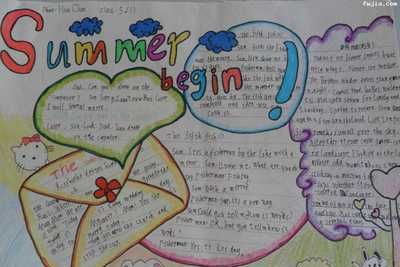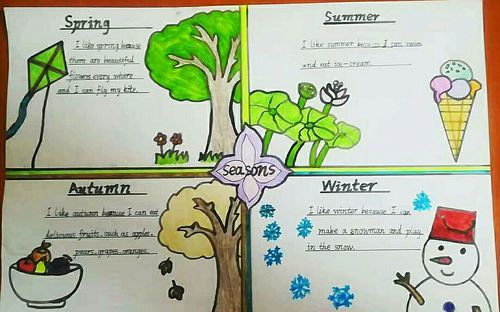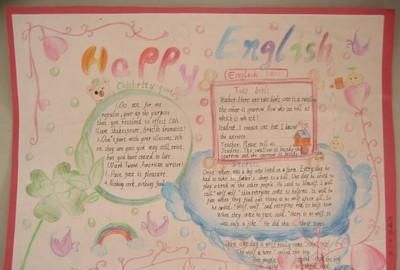本文目录
小学五年级英语手抄报内容资料
Far and away the most important holiday in China is Spring Festival, also known as the Chinese New Year. To the Chinese people it is as important as Christmas to people in the West. The dates for this annual celebration are determined by the lunar calendar rather than the Gregorian calendar, so the timing of the holiday varies from late January to early February.
To the ordinary Chinese, the festival actually begins on the eve of the lunar New Year's Day and ends on the fifth day of the first month of the lunar calendar. But the 15th of the first month, which normally is called the Lantern Festival, means the official end of the Spring Festival in many parts of the country.
Preparations for the New Year begin the last few days of the last moon, when houses are thoroughly cleaned, debts repaid, hair cut and new clothes purchased. Houses are festooned with paper scrolls bearing auspicious antithetical couplet (as show on both side of the page) and in many homes, people burn incense at home and in the temples to pay respects to ancestors and ask the gods for good health in the coming months.
"Guo Nian," meaning "passing the year," is the common term among the Chinese people for celebrating the Spring Festival. It actually means greeting the new year. At midnight at the turn of the old and new year, people used to let off fire-crackers which serve to drive away the evil spirits and to greet the arrival of the new year. In an instant the whole city would be engulfed in the deafening noise of the firecrackers.
On New Year's Eve, all the members of families come together to feast. Jiaozi, a steamed dumpling as pictured below, is popular in the north, while southerners favor a sticky sweet glutinous rice pudding called nian gao.
"CHRISTMAS (i.e. the Mass of Christ), in the Christian Church, the festival of the nativity of Jesus Christ. The history of this feast coheres so closley with that of Epiphany (q.v.), that what follows must be read in connexion with the article under that heading.
The earliest body of gospel tradition, represented by Mark no less than by the primitive non-Marcan document embodied in the first and third gospels, begins, not with the birth and childhood of Jesus, but with his baptism; and this order of accretion of gospel matter is faithfully reflected in the time order of the invention of feasts. The great church adopted Christmas much later than Epiphany; and before the 5th cntury there was no general consensus of opinion as to when it should come in the calendar, whether on the 6th of January, or the 25th of March, or the 25th of December.
The earliest identification of the 25th of December with the birthday of Christ is in a passage otherwise unknown and probably spurious, of Theophilus of Antioch (A.D. 171-183), preserved in Latin by the Magdeburg centuriators (i.3, 118), to the effect that the Gauls contended that as they celebrated the birth of the Lord on the 25th of December, whatever day of the week it might be, so they ought to celebrate the Pascha on the 25th of March when the resurrection befell.
The next mention of the 25th of December is in Hippolytus' (c. 202) commentary on Daniel iv.23. Jesus, he says, was born at Bethlehem on the 25th of December, a Wednesday, in the forty-second year of Augustus. This passage also is almost certainly interpolated. In any case he mentions no feat, nor was such a feast congruous with the orthodox ideas of that age. As late as 245 Origen, in his eighth homily on Leviticus, repudiates as sinful the very idea of keeping the birthday of Christ "as if he were a king Pharoah." The first certain mention of Dec. 25 is in a Latin chronographer of A.D. 354, first published entire by Mommsen. [1--In the _Abhandlungen der sachsischen Akademie der Wissenschaften_ (1895). Note that in A.D. 1, Dec. 25 was a Sunday and not a Friday.] It runs thus in English:
"Year 1 after Christ, in the consulate of Caesar and Paulus, the Lord Jesus Christ was born on the 25th of December, a Friday and 15th day of the new moon." Here again no festal celebration of the day is attested.
There were, however many speculations in the 2nd century about the date of Christ's birth. Clement of Alexandria, towards its close, mentions several such, and condemns them as superstitions. Some chronologists, he says, alleged the birth to have occurred in the twenty-eighth year of Augustus, on the 25th of Pachon, the Egyptian month, i.e. the 20th of May. These were probably the Basilidian gnostics. Others set it on the 24th or 25th of Pharmuthi, i.e., the 19th or 20th of April. Clement himself sets it on the 17th of November, 3 B.C. The author of a Latin tract, called the _De Pascha computus_, written in Africa in 243, sets it by private revelation, _ab ipso deo inspirati_, on the 28th of March. He argues that the world was created perfect, flowers in bloom, and trees in leaf, therefore in spring; also at the equinox, and when the moon just created was full. Now the moon and sun were created on a Wednesday. The 28th of March suits all these considerations. Christ, therefore, being the Sun of Righteousness, was born on the 28th of March.
The same symbolical reasoning led Polycarp [2--In a fragment preserved by an Armenian writer, Ananias of Shirak.] (before 160) to set his birth on Sunday, when the world's creation began, but his baptism on Wednesday, for it was the analogue of the sun's creation. On such grounds certain Latins as early as 354 may have transferred the human birthday from the 6th of January to the 25th of December, which was then a Mithraic feast and is by the chronographer above referred to, but in another part of his compilation, termed _Natilis invicti solis_, or birthday of the unconquered Sun. Cyprian (_de orat. dem._ 35) calls Christ _Sol verus_, Ambrose _Sol novus noster_ (Sermo vii. 13), and such rhetoric was widespread.
The Syrians and Armenians, who clung to the 6th of January, accused the Romans of sun-worship and idolatry, contending with great probability that the feast of the 25th of December had been invented by disciples of Cerinthus and its lections by Artemon to commemorate the _natural_ birth of Jesus. Chrysostom also testifies the 25th of December to have been from the beginning known in the West, from Thrace even as far as Gades. Ambrose, _On Virgins_, iii. ch. 1, writing to his sister, implies that as late as the papacy of Liberius 352-356, the Birth from the Virgin was feasted together with the Marriage of Cana and the Banquet of the 4000 (Luke ix.13), which were never feasted on any other day but Jan. 6.
Chrysostom, in a seermon preached at Antioch on Dec. 20, 386 or 388, says that some held the feast of Dec. 25 to have been held in the West, from Thrace as far as Cadiz, from the beginning. It certainly originated in the West, but spread quickly eastwards. In 353-361 it was observed at the court of Constantius. Basil of Caesarea (died 379) adopted it. Honorius, emperor (395-423) in the West, informed his mother and brother Arcadius (395-408) in Byzantium of how the new feast was kept in Rome, separate from the 6th of January, with its own _troparia_ and _sticharia_.
They adopted it, and recommended it to Chryostom, who had long been in favour of it, as were the other three patriarchs, Theophilus of Alexandria, John of Jerusalem, and Flavian of Antioch. This was under Pope Anastasius, 398-400. John or Wahan of Nice, in a letter printed by Combefis in his _Historia monothelitarum_, affords the above details. The new feast was communicated by Proclus, patriarch of Constantinople (434-446), to Sahak, Catholicos of Armenia, about 440. The letter was betrayed to the Persian king, who accused Sahak of Greek intrigues, and deposed him. However, the Armenians, at least those within the Byzantine pale, adopted it for about thirty years, but finally abandoned it together with the decrees of Chalcedon early in the 8th century.
Many writers of the period 375-450, e.g. Epiphanius, Cassian, Asterius, Basil, Chrysostom and Jerome, contrast the new feast with that of the Baptism as that of the birth _after the flesh_, from which we infer that the latter was generally regarded as a birth according to the Spirit. Instructive as showing that the new feast travelled from West eastwards is the fact (noticed by Usener) that in 387 the new feast was reckoned according to the Julian calandar by writers of the province of Asia, who in referring to other feasts use the reckoning of their local calendars. As early as 400 in Rome an imperial rescript includes Christmas among the three feasts (the others are Easter and Epiphany) on which theatres must be closed. Epiphany and Christmas were not made judicial _sine dies_ until 534.
For some years in the West (as late as 353 in Rome) the birth feast was appended to the baptismal feast on the 6th of January, and in Jerusalem it altogether supplanted it from almost 360 to 440, when Bishop Juvenal introduced the feast of the 25th of December. The new feast was about the same time (440) finally established in Alexandria. The _quadregesima_ of Epiphany (i.e., the feast of the presentation in the Temple, or _hupapante_) continued to be celebrated in Jerusalem on the 14th of February, forty days afer the 6th of January, until the reign of Justinian. In most other places it had long before been put back to the 2nd of February to suit the new Christmas. Armenian historians describe the riots, and display of armed force, without which Justinian was not able in Jerusalem to transfer this feast from the 14th to the 2nd of February.
The grounds on which the Church introduced so late as 350-440 a Christmas feast till then unknown, or, if known, precariously linked with the baptism, seem in the main to have been the following: (1) The transition from adult to infant baptism was proceeding rapidly in the East, and in the West was well-nigh completed. Its natural complement was a festal recognition of the fact that the divine element was present in Christ from the first, and was no new stage of spiritual promotion coeval only with the descent of the Spirit upon him at baptism.
The general adoption of child baptism helped to extinguish the old view that the divine life in Jesus dated from his baptism, a view which led the Epiphany feast to be regarded as that of Jesus' spiritual rebirth. (2) The 4th century witnessed a rapid diffusion of Marcionite, or, as it was now called, Manichaean propaganda, the chief tenet of which was that Jesus either was not born at all, was a mere phantasm, or anyhow did not take flesh of the Virgin Mary. Against this view the new Christmas was a protest, since it was peculiarly the feast of his birth in the flesh, or as a man, and is constantly spoken of as such by the fathers who witnessed its institution.
In Britain the 25th of December was a festival long before the conversion to Christianity, for Bede (_De temp. rat._ ch. 13) relates that "the ancient people of the Angli began the year on the 25th of December when we now celebrate the birthday of the Lord; and the very night which is now so holy to us, they called in their tongue _modranecht (modra niht)_, that is, the mothers' night, by reason we suspect of the ceremonies which in that night-long vigil they performed." With his usual reticence about matters pagan or not orthodox, Bede abstains from recording who the mothers were and what the ceremonies. In 1644 the English puritans forbad any merriment or religious services by act of Parliament, on the ground that it was a heathen festival, and ordered it to be kept as a fast. Charles II. revived the feast, but the Scots adhered to the Puritan view.
Outside Teutonic countries presents are unknown. Their place is taken in Latin countries by the _strebae_, French e'trennes_, given on the 1st of January; this was in antiquity a great holiday, wherefore until late in the 4th century the Christians kept it as a day of fasting and gloom. The setting up in Latin churches of a Christmas _cr`eche_ is said to have been originated by St Francis.
AUTHORITIES -- K.A.H. Kellner, _Heortologie_ (Freiburg im Br., 1906), with Bibliography; Hospinianus, _De festis Christianorum_ (Geneva, 1574); Edw. Mart`ene, _De Antiquis Ecclesiae Ritibus_, iii.31 (Bassani, 1788); J.C.W. Augusti, _Christl. Archaologie_, vols. i. and v. (Leipzig, 1817- 1831); A. J. Benterim, Denkwurdigkeiten_, v. pt. i. p. 528 (Mainz, 1825, &c.); Ernst Friedrich Wernsdorf, _De originibus Solemnium Natalis Christi_ (Wittenberg, 1757, and in J.E. Volbeding, _Thesaurus Commentationum_, Leipzig, 1847); Anton. Bynaeus, _De Natali Jesu Christi_ (Amsterdam, 1689); Hermann Usener, _Religionsgeschichtlicke Untersuchungen_ (Bonn, 1889); Nik. Niles, S.J., _Kalendarium Manuale_ (Innsbruck, 1896); L. Duschesne, _Origines du culte chre'tien_ (3e e'd., Paris, 1889).
-- Frederick Cornwallis Conybeare, M.A., D.Th. (Giessen). Fellow of the British Academy. Formerly Fellow of University College, Oxford. Author of _The Ancient Armenian Texts of Aristotle_; _Myth, Magic and Morals_; &c."
12月25日,是基督教徒纪念耶稣诞生的日子,称为圣诞节。
从12月24日于翌年1月6日为圣诞节节期。节日期间,各国基督教徒都举行隆重的纪念仪式。圣诞节本来是基督教徒的节日,由于人们格外重视,它便成为一个全民性的节日,是西方国家一年中最盛大的节日,可以和新年相提并论,类似我国过春节。
西方人以红、绿、白三色为圣诞色,圣诞节来临时家家户户都要用圣诞色来装饰。红色的有圣诞花和圣诞蜡烛。绿色的是圣诞树。它是圣诞节的主要装饰品,用砍伐来的杉、柏一类呈塔形的常青树装饰而成。上面悬挂着五颜六色的彩灯、礼物和纸花,还点燃着圣诞蜡烛。
红色与白色相映成趣的是圣诞老人,他是圣诞节活动中最受欢迎的人物。西方儿童在圣诞夜临睡之前,要在壁炉前或枕头旁放上一只袜子,等候圣诞老人在他们入睡后把礼物放在袜子内。在西方,扮演圣诞老人也是一种习俗。
圣诞的由来
圣诞节的由来耶稣的生日究竞是哪一天,其实早无据可查。为什么要把12月25日定为圣诞节呢?这是在5世纪中叶由教会规定的。公元354年,在“菲洛卡连”日历中第一次写明12月25日是耶稣的生日,到5世纪西方普遍接受了这个日期为圣诞节。
圣诞树
据称,圣诞树最早出现在古罗马12月中旬的农神节,德国传教士尼古斯在公元8世纪用纵树供奉圣婴。随后,德国人把12月24日作为亚当和夏娃的节日,在家放上象征伊甸园的“乐园树”,上挂代表圣饼的小甜饼,象征赎罪;还点上蜡烛,象征基督。到16世纪,宗教改革者马丁.路德,为求得一个满天星斗的圣诞之夜,设计出在家中布置一颗装着蜡烛的圣诞树。不过,西方关于圣诞树的来历流行着另一种说法:有个善良的农民,在圣诞节那天,热情地招待了一名流浪的孩子,临别时,孩子折下一树枝插在地上树枝立即长成大树,孩子指着这树对农民说,每年今日,树上都长满礼物,以报答你们的盛情。所以,今天人们所见的圣诞树上总是挂满了小礼物。
圣诞歌
长期以来,一直流行的圣诞歌主要有三个,一个是《平安夜》;一个是《听,天使报佳音》;第三个是《铃铛儿响叮当》。
圣诞老人
圣诞老人原指公元4世纪时小亚细亚专区 的主教尼古拉,他因和蔼可亲慷慨济贫万里闻名。到了6世纪,东方把他尊称为圣尼古拉。由于民间有关尼古拉的传说中,都联系到少年儿童和礼物,从此,圣诞老人便成为专门在圣诞节向孩子们送礼物的慈祥老人的形象。到了18世纪,通过文学和绘画,圣诞老人逐渐成为身穿红外衣的白胡子、白眉毛老人形象。
圣诞卡
世界上第一张圣诞卡是1843年英国人亨利.高乐爵士提议,由约翰.卡尔葛.荷斯利设计的。卡片上画的是一个贵族家庭,三代人一齐举杯对一位不在场的亲友表示祝贺。当时他印了1000张,没有用完的印刷厂就以每张1先令的价钱卖出。圣诞卡就这样诞生了。
圣诞礼物
据《圣经》记载,来自东方的圣人在耶稣降生的时候赠送礼物,这就是圣诞老人为儿童赠送礼品习俗的由来。英国少年儿童在圣诞前夕把长统袜子放在壁炉旁,相信圣诞老人在夜里会从大烟囱下来,给他们带来满袜子的礼物。法国的少年儿童把鞋放在门口,让“圣婴来时把礼物放在鞋里面。”
圣诞大餐
正像中国人过春节吃年饭一样,欧美人过圣诞节也很注重全家人围坐在圣诞树下,共进节日美餐。圣诞大餐吃火鸡的习俗始于1620年。这种风俗盛于美国。英国人的圣诞大餐是烤鹅,而非火鸡。奥大利人爱在平安夜里,全家老小约上亲友成群结队地到餐馆去吃一顿圣诞大餐,其中,火鸡、腊鸡、烧牛仔肉和猪腿必不可少,同时伴以名酒,吃得大家欢天喜地.
每年的1月1日为元旦,是新年的开始。“元日”是合成词,按单个字来讲,“元”是第一或开始的意思,“旦”字的原意是天亮或早晨。我国在发掘大汶口文化遗物中,发现一幅太阳从山颠升起,中间云烟缭绕的图画。经考证,这是我国最古老的“旦”字写法。后来,在殷商的青铜器铸铭上,又出现了被简化的“旦”字。“旦”字是以圆圆的太阳来表示的。“日”下面的“一”字表示地平线,意为太阳从地平线上冉冉升起。南朝文史家肖子云在他的《介雅》中记载有“四气新元旦,万寿初今朝”,看来那时已将旦为一日的开始,引申为一年的第一天了。 但是,我国古人说的元旦,却并不是公历的1月1日,而是正月初一,又称元日。中国历史上的年号并不是公元纪年,而是每个皇帝每个朝代都有单独的纪年,是阴历纪年。现行的公元纪年,是西方历法的体现。是以基督诞生为公元1年。中国只是到了中华民国以后才逐渐改用公元纪年。因此,中国农历的正月初一既春节比公历的元旦更有节日气氛。
“元”有始之意,“旦”指天明的时间,也通指白天。元旦,便是一年开始的第一天。“元旦”一词,最早出自南朝梁人萧子云《介雅》诗:“四气新元旦,万寿初今朝。”宋代吴自牧《梦梁录》卷一“正月”条目:“正月朔日,谓之元旦,俗呼为新年。一岁节序,此为之首。”元旦,《书·舜典》中叫“元日”,汉代崔瑗《三子钗铭》中叫“元正”;晋代庾阐《扬都赋》中称作“元辰”;北齐时的一篇《元会大享歌皇夏辞》中呼为“元春”;唐德宗李适《元日退朝观军仗归营》诗中谓之“元朔”。自来元旦指的是夏历(农历、阴历)正月初一。在汉语各地方言中有不同叫法,有叫“大年初一”的,有叫“大天初一”的,有叫“年初一”的,一般又叫“正月初一”。
我国历代元旦的月日并不一致。夏代在正月初一,商代在十二月初一,周代在十一月初一,秦始皇统一六国后,又以十月初一日为元旦,自此历代相沿未改(《史记》)。汉武帝太初元年时,司马迁创立了“太初历”,这才又以正月初一为元旦,和夏代规定一样,所以又称“夏历”,一直沿用到辛亥革命。中华民国建立,孙中山为了“行夏正,所以顺农时;从西历,所以便统计”,定正月初一(元旦)为春节,而以西历(公历)1月1日为新年。1949年9月27日,中国人民政治协商会议第一届全体会议通过使用“公元纪年法”,将农历正月初一称“春节”,将公历1月1日定为“元旦”。
过圣诞节已经成为世界各地的风俗习惯,可是你可曾探究过这日子的由来?你知道为什麼要庆祝这日子吗?圣诞节的由来可追溯到2001年前耶稣的诞生。
确实年份虽然已无从考察,但大多数考古学家都认为应该是在划分世纪的那一年(即公元前一年),只不过正确的出生日期无法确定。因此早期的基督教徒便以罗马帝国时期的密司拉教派,在每年一二月二十五日纪念太阳神诞辰的第一天定为【圣诞节】。所以圣诞节在宗教上是基督教徒纪念耶诞生的一个重要节日。根据圣经的记载,耶稣诞生在犹太的一座小城--伯利恒。马利亚,也就是耶稣的母亲,因圣灵的感动而怀孕,在梦中天使加百列向她显现,告诉她,她将要生下神的儿子,他要被称为耶稣。就在与丈夫约瑟返往家乡时,所有的旅店客满,因此马利亚被迫在马槽生下耶稣。遥远的东方有三博士得到神的启示,追随天上的一颗明亮星星找到了耶稣,俯伏拜他,揭开宝盒,拿出黄金、乳香、没药为礼物献给他。在伯特利野地的牧差人也听到天使的声音从天上发出,向他们款耶稣降生的佳音。在民俗上,那可就要追溯到德国了。在德国,圣诞节前的四个星期天分别秩为第一、二、三、四个待降节(advent)。在第一个待降节左右就开始了耶诞市集,而第一个待降节当天,家家户户都会将待降花圈(adventskranz)中第一根蜡烛点燃,之后每个待降节分吸再依序点燃待降花圈的其他蜡烛,等第四根蜡烛被点燃的时候,就代表耶诞节要来啦!这段期间德国家庭同时开始准备各项采买、装饰,大扫除的工作,这像不像我们的腊月呢?而小朋友也会得到一份「耶诞日历」(ADVENTSKALENDER),这是一个纸盒,上面会有1到24个小「门」,每个小门后面都有一样小玩具或糖果之类的东西。就像我们小时候在住家附的杂货店「抽」东西一样,小朋友从十二月一号开始每天可以开一个门,刚好开到十二月二十四的耶诞节前夕。不过顽皮的小朋友通常迫不及待地在第一天就将它全部打开了!

春天英语手抄报内容资料
一、春季。
四季的一种。从节气意义上讲,春季的开始是在立春(2月2日至5日之间),春季的结束在立夏(5月5日至7日之间)。在欧美,春季从中国的春分开始,到夏至结束。在爱尔兰,2月~4月被定为春季。
在春季,地球的北半球开始倾向太阳,受到越来越多的太阳光直射,因而气温开始升高。随着冰雪消融,河流水位上涨。春季植物开始发芽生长,许多鲜花开放。冬眠的动物苏醒,许多以卵过冬的动物孵化,鸟类开始迁徙,离开越冬地向繁殖地进发。许多动物在这段时间里发情,因此中国也将春季称为“万物复苏”的季节。春季气温和生物界的变化对人的心理和生理也有影响。
春季是一年的第一个季节,有很多划分四季的方法。在日常生活中,人们通常把立春节气的到来作为春季的开始,立春是从天文学角度来划定的。气象部门一般以阳历划分四季,3-5月为春季。但这样的划分方法都有个弊端,按这样的方法3月份我国都属于春季,这时候长江流域固然桃红柳绿,一派春光,可是黑龙江省却依然寒风刺骨冰天雪地,而海南岛则已经有夏日的气息了。
因此,气象工作者就研究出一种尽量符合自然景象的四季划分标准,以5天平均气温为标准,把冬季以后五天平均气温稳定通过10℃时开始进入春季,当温度高于22℃时意味着春季的结束夏季的开始。
二、冬季。
冬季是四季之一,秋春之间的季节。天文学上认为是从12月至3月,中国习惯指立冬到立春的三个月时间,也指农历“十、十一(冬)、十二(腊)月”一共三个月。在南北半球所处的时间不同。按气象意义划分,在南半球温带及寒带,冬季在6、7、8月份(也可以按星座标准说是5月21日~8月22日),在北半球温带及寒带,冬季在12、1、2月份(也可以按星座标准说是11月21日~2月18日)。按节气意义划分,冬季从立冬开始,到立春结束,西方人则普遍称冬至至春分为冬季。 从气候学上讲,平均气温连续5天低于10℃算作冬季。
冬季在很多地区都意味着沉寂和冷清。生物在寒冷来袭的时候会减少生命活动,很多植物会落叶,动物会选择休眠,有的称作冬眠。候鸟会飞到较为温暖的地方越冬。
冬季有六个节气,实际上是三个节和三个气:立冬、小雪、大雪、冬至、小寒和大寒。
在北半球或南半球,冬季是最寒冷的季节,即使温带的气温也可能降到0℃以下。
在冬季,很多地方会经历降雪,北方大部分地方的冰雪到春天才会融化。
冬季太阳直射点向南(北)移动到南回归线(或北回归线),再折回向北(南)。

五年级英语我最喜欢的节日手抄报
(春天)My favorite season is spring.
Spring is beautiful and green. In spring, the air is fresh, the sky is blue, the clouds are white. I often wear a red sweater and blue jean. I can fly kites on the green grass. In March we can plant trees. In spring, the weather is always sunny and warm, usually I go shopping. Sometimes I go hiking and climb mountains. I like spring.
(夏天)My favorite season is summer .because I can go to the beach to swimming.I can have sunbath on the beach. I can go to the store to buy some ice creans! I can calling my friends go to outside!Summer is a fun season !I like summer very much!
(秋天)My favorite season is fall. Why do I like it? Because it is not that hot like summer and not that cold like winter. Most important of all, fall is the best season for us to eat. There is much delicious food waiting for us in the fall. To me, fall is the best of all seasons.
(冬天)Although winter means cold weather, I love it all the same. I think winter is a beautiful season, especially when it snows. Snowflakes fall down naughtily. They fall on branches of trees, on roofs of houses and on wheat fields. Soon the whole earth will be dressed in white. Everything is shining in the sun. Every time it snows, I will remember an old saying, "Winter has come, can spring be far away?'
希望能帮助你

关于春天的英语手抄报内容 三年级
春天来了,大地上的每一个角落者充满了春天的气息。
Spring is coming, every corner of the earth who filled with spring in the air.
校园里,到处都是春光明媚的鲁象。
Campus, everywhere is spring LuXiang.
柳树抽出了细细的柳丝,上面缀洁了淡黄色的嫩叶;
Willow drew thin LiuSi, above compose clean the flaxen leaves;
小草带着泥土的芳香钻了出来,一丛丛,一簇簇,又嫩又绿花儿也伸了伸懒腰,打了个哈欠,探出了小脑袋;
The grass with the fragrance of the earth in your drill out, drifts, and extinct volcanoes, tender and green flowers also stretches out his arms and yawn, small head out;
小朋友们都脱掉了笨重的冬衣,换上了既轻便又鲜艳的春装;
The kids are off heavy winter clothes, put both light and bright spring clothing;
小鸟们从家里飞了出来,唱着动听的歌,告诉我们:春天来了!
The birds fly out from home, and sang hit song, tell us: spring is coming!
春天真的来了,在池塘里,在田野上,在天空中,到处都焕发着勃勃生机。
Spring is really in the pond, in the field, in the sky, everywhere the glow vitality.
大自然的景色也变得丰富多彩起来。
Nature scenery becomes rich and colorful up.
晴天里,暖洋洋的阳光照在身上,软绵绵的春风拂在脸上,既温暖又舒服:在下雨天,时不时炸响一阵阵春雷,既惊险又刺激。
Sunny day, warm sunshine in the body, the soft breeze blows on the face, both warm and comfortable: in the rainy day, occasionally exploding waves ChunLei, both thrilling and exciting.
春天的景色太美了,春天里人们的心情更美。
Spring scenery was so beautiful, the mood in the spring people more beautiful.
佝偻了整整一个冬季的腰板挺直了,欢快的笑脸充满着希望。
For a winter slouch compass, bright smiling face standing full of hope.
公园里又热闹起来了,照相的青年人,钓鱼的老人,捕捉昆虫的小朋友,一个个陶醉在大自然的怀抱里,流连忘返。
The park and lively up, take a picture of young people, fishing, old man catching insects children, each one intoxicated in the bosom of nature, reluctant to leave.
春天里人们更忙了。
People are more busy in the spring.
俗话说:一年之计在于春。
As the saying goes: a year's plan starts with spring.
你看,在城市的大街小巷,来来往往地穿梭着忙碌的身影,乡村的田地里,农民们在播洒着希望的种子。
You see, in the city streets, to shuttle busy ground-level figure, rural fields, farmers in the seeds of hope is like.
教室的墙壁上贴着新学期的课表,一本本新书中,有好多好多的知识果实等待着我们去采撷。
On the walls of the classroom of the new term YiBenBen new book, schedule, a lot of knowledge fruit is waiting for us to gather.
我热爱春天,我喜欢闻到花儿的芳香,看到大树的新绿,听到小乌的欢唱。
I love spring, I like to smell the fragrance of flowers, see the tree's green, hear little uzziah sings.
我热爱春天,因为春天充满了生机,充满了新的希望!
I love spring because full of vitality, full of new hope!

以上就是关于五年级英语手抄报四季内容 ,小学五年级英语手抄报内容资料的全部内容,以及五年级英语手抄报四季内容 的相关内容,希望能够帮到您。

